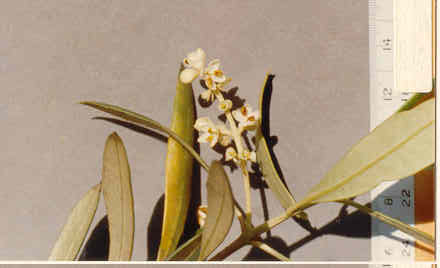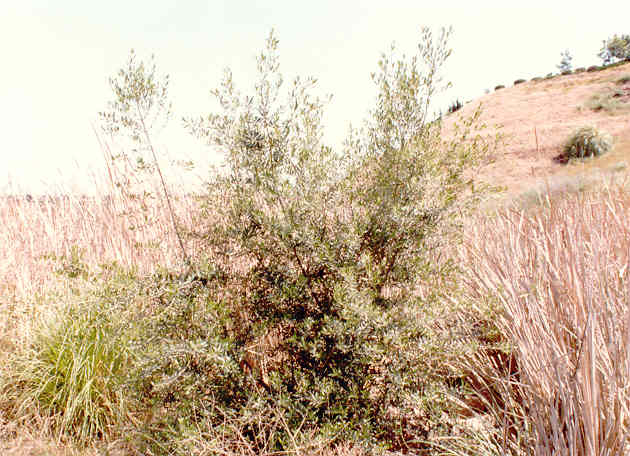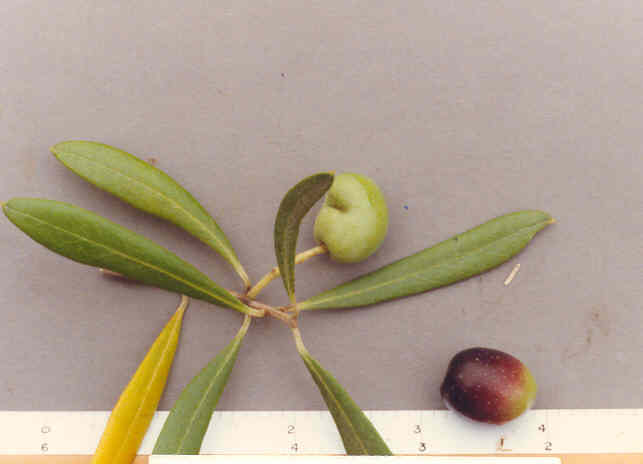
Olea europaea L.
 |
Olea europaea L.
Oleaceae (Olive Family)Western AsiaOlive |
May Photo
Plant Characteristics:
Evergreen tree to 25 ft. or more, with thornless nearly terete branches;
lvs. opposite, elliptic, oblong or lanceolate, 1-3 in. long, dark green
above, densely silvery-lepidote beneath; panicles shorter than lvs., the fls.
white, fragrant; drupe subglobose or oblong, black and shining when ripe, from
1/2-1 1/2 in. long.
Habitat:
Escape from cult. Bloom
period not shown in Bailey, however, my photo of the fls. was taken in May.
Name:
O-lea, classical Latin name for
the olive tree. (Bailey 795).
Europea, of Europe. (Bailey
14). Oleum
was the Roman Latin name for olive oil. Oleum derives from the Greek, elaia,
for olive or olive tree. Oil,
English, from Latin, oleum.
(John Johnson).
General: Uncommon in the study area, having been found twice in the 23rd St. area at a rather low elevation, possibly +15 ft, along Back Bay Drive one-eighth mile southerly of the old salt works dike and near the bluff top at Eastbluff North. (my comment). Olive oil is an often used remedy for constipation and is popular as a laxative for children, being often substituted for Castor Oil. Olive oil is helpful in removing stony deposits from the bile and removes intestinal worms. It is used externally, either alone or with other ingredients, as an ointment or a salve for bruises, burns, scalds and various skin conditions. It is also helpful in rheumatism conditions. It is valuable for rubbing gently on the gums of teething children and by absorption keeps the bowels regular. (Kadans 159). The olive fruits were the best source of liquid oil for the Mediterranean peoples; the oil was used in foods and food preparation, for lamps, for personal grooming, for wood treatment, paints, cosmetics, lubricants and many other purposes. It became a symbol of wealth. (John Johnson). It is said that an extract of olive leaves if effective against infections and virulent microbes that may be immune to antibiotics. The extract operates in a multifaceted fashion helping the body to overcome microbial invasions by bringing about a critical interference with certain amino acid production procedures necessary for a specific virus, bacterium or microbe to survive. Also by interference with viral infection by inactivating viruses or by preventing virus shedding, budding or assembly at the cell membrane and by direct penetration into infected host cells. This multifaceted approach is why olive leaf extract is so efficacious against so many diseases that involve the immune system. Other diseases respond to the extract, including coronary artery disease. (The Healthy Cell News, winter 2000 p.17, no author given). Olea species have been known to cause hay fever and asthma. (Fuller 380). Nearly 40 species of evergreen trees and shrubs native in trop. and warm parts of the Old World to New Zealand, one extensively grown for its edible fruit. (Bailey 795). Widely cultivated for food and cooking oil in Mediterranean for +/- 6000 years. (Hickman, Ed. 776). Naturalized in California. (Hickman, Ed. 1344).
Text Ref:
Bailey 795; Hickman, Ed. 776.
Photo Ref:
May 3 84 # 8,9; Aug, Sept, Oct 88 # 20.
Identity: by R. De Ruff.
First Found: May 1984.
Computer Ref: Plant Data 329.
Plant specimen donated to UC Riverside in 2004.
Last edit 8/7/05.
 |
 |
May Photo October Photo